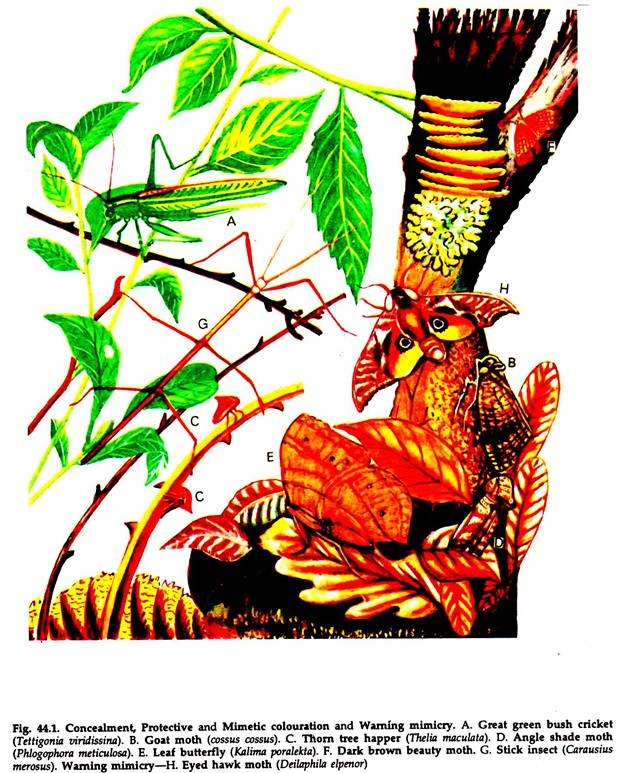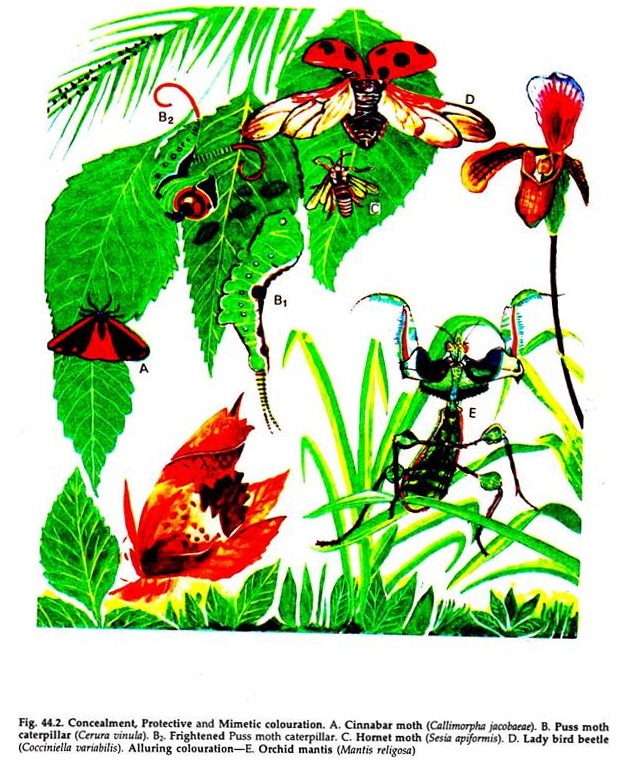In this article we will discuss about the colouration in animals, explained with the help of suitable diagrams.
Colouration:
Colours directly helping the animals in their survival are valuable colours. On the basis of their uses they have been placed under several heads.
Sympathetic, cryptic or concealing colouration:
ADVERTISEMENTS:
The colour of the animal blends with the surroundings and the animal cannot be detected easily. It may be protective or aggressive.
Protective and aggressive colouration:
It is of value both to the prey and the predator. To the first, it is protective colouration, e.g. the Arctic hare and to the second, it is aggressive colouration, e.g. the Arctic fox.
Local and seasonal colouration:
ADVERTISEMENTS:
The same species vary in colour in two ways:
1. The caterpillar of the hawk moth, Sphinx convolvuli, when full grown, is either green, like the food plant or brown, resembling the ground colour.
2. The varying hare, Lepus variables, retains brown colour in southern Sweden during winter; the same species remains white for six or seven months in the higher Alps, for nine months in the south of Norway and white throughout the year in northern Greenland.
Standard faunal colour:
ADVERTISEMENTS:
The surrounding of an animal influences its colouration to a considerable (Fig. 44.1) extent; the deserts, the plains, the jungles and other habitats, all play some roles in the life of their inhabitants.
Concealment colours:
1. The camel, gazelle, lion and other desert animals are grey, matching the colour of the sand.
2. The buckskin horse simulate the colour of dry grass.
3. The tiger and zebra are striped to blend with the shades of trees or long grasses.
ADVERTISEMENTS:
4. Arctic creatures are white.
5. Many sea birds are steel grey or blue above and white ventrally.
6. Nocturnal animals are mottled brown or grey.
All perfectly match with the surrounding colours.
Alluring colours:
The colouration which attracts other animals for one or more reasons.
1. Certain spiders allure insects by closely resembling an orchid blossom both in colour and form.
2. Some African lizards have protective colouration all over the body, except for a brilliant patch of colour at the corner of the mouth to attract the prey.
3. The orchid mantis with its anterior portion resembling an orchid flower attracts insects on which it feeds (Fig. 44.2).
Warning or revealing colours:
The colour resembling that of poisonous or distasteful animals like stinging wasps, poisonous snakes, etc. serves as warning and the animals are immune from attack. The colours are usually conspicuous reds or yellows. Many moths, butterflies and their caterpillars protect them by such adaptation. Sometimes the attitude of dangerous animals is associated with warning colouration.
1. A small moth, Smerinthus, has large eye-like spots on the hind-wings, which are concealed under the fore-wings. When the fore-wings are raised, the eye-like markings, resembling the markings on the back of the head of a cobra, creates terror in the assailant and it retreats.
Mimetic colouration:
The colour resembling an animal or even an inanimate object to conceal the animal or to warn others is called mimetic colouration (Fig. 44.1). The walking-stick insect (Carausius), the walking-leaf insect (Phyllium), the non-poisonous snakes imitating colour of poisonous coral snakes are examples of mimetic colouration.
Signal marks:
It is an adaptation in gregarious animals to send warning signals to fellow animals heralding some danger.
1. A conspicuous white area in the posterior part of the body of the Virginian deer remains covered with lowered tail. Sensing danger when one starts off, the tail goes up, exposing the white area. This acts as a warning and other members of the herd are instantly in full retreat.
2. The signal flag of the cotton tail rabbit Lepus sylvaticus gleams in the dark and directs the young to safety.
Recognition colouration:
Colouration helping members of the same species to recognise one another is called recognition mark or sympathetic colouration.
1. The dorsal surface of a brook-trout (Salvelinus fontinalis) is dusky, while the ventral surface is light-coloured. Red and orange spots are present on the sides of the body. In a shadowy pool the colours of the dorsal and ventral surfaces harmonize with the surroundings when viewed from either above or below. But the characteristic spots on the sides are clearly visible to its fellow members at the same level.
2. Many moths, butterflies and other insects possess sympathetic colours on the exposed portions, chiefly wings.
Confusing colouration:
Sudden disappearance of the sympathetic flours and harmonization of the body colour with the surroundings confuse the pursuer or the viewer. It is known as confusing colouration.
1. The eyes of a viewer or a pursuer follow the brilliant recognition colouring of a moth or a butterfly on the surface exposed in flight but not at rest. The colour disappears with the settling of the insect and the viewer loses sight of it.
2. Brilliant sympathetic colour is present on the underside of the tail of certain somber-coloured lizards. The colour is exposed in running lizards and disappears when it stops and the tail is lowered. The body colour harmonizes with the sand and the lizard escapes sight of the pursuer.
Sexual colouration:
The colouration with the attainment of sexual maturity is sexual colouration. The males of many species of insects, birds, mammals attain beautiful colouration at sexual maturity, while the females have only protective colouration.
1. The protective colouration of female birds help them to escape notice of predators during nesting.
2. The spotted coat of young deer, lion and puma is of protective value under the conditions surrounding babyhood. The infantile colouration increases the percentage of survival in young animals.

